Nokia Lumia 630 Review
by Brett Howse on July 22, 2014 8:00 AM EST- Posted in
- Smartphones
- Microsoft
- Nokia
- Mobile
- windows phone
Display
The Lumia 630 display is surprisingly good, especially at this price point. Although not the brightest display around, it does have decent contrast due to good black levels. It also has the ClearBlack polarizer layer, which is a feature of many Lumia phones. ClearBlack uses linear polarizer and circular polarizer retardation layers between the phone and the display to attenuate reflections, much like polarized sunglasses work. The advantage is a less reflective display, which helps with outdoor readability.
The other part of outdoor readability though is a bright display, and here the results aren’t quite as good, with the Lumia 630 only able to achieve 330 nits at maximum brightness. I did find though that it was generally bright enough to use outdoors, however most smartphones have an ambient light sensor. The Lumia 630 does not, so that means that there is no auto-brightness control on this device, which means using it outdoors you have to manually adjust the brightness. Nokia has attempted to remedy this by including three preset brightness levels which are all infinitely adjustable, and one of the quick launch buttons in the action center is set as display brightness out of the box. For those keeping track – two of the four quick launch buttons of this device are set at the factory to overcome missing features from the phone.
The biggest negative with this display though is the resolution. 854x480 (the bottom 54 pixels are for the on-screen buttons) on a 4.5” display results in around 218 pixels per inch. Although this can be slightly forgiven due to the cost of this device, it’s definitely a drawback because you can clearly see the individual pixels on a display this size with that resolution. The competition from Android at around this price point is the Moto G, which sports a 1280x720 display and a much more impressive 329 ppi. The Moto E, which is slightly smaller at 4.3”, also packs in 960x540 pixels for 256 ppi. The Lumia 630 doesn’t live in a vacuum, and 800x480 effective resolution is just too low.
One other complaint with the display before we move on to color testing is that the Gorilla Glass has an almost matte texture to it, and I found in my time with the device that it attracts fingerprints much more easily than other phones I’ve used, including the 620 from last year. It’s somewhat annoying, but not something that really bothered me, it’s just noticeable.
To test the display accuracy, we turn to Spectralcal’s CalMAN 5 software package with a custom workflow. We utilize the X-Rite i1Pro Spectrophotometer for color accuracy and saturation, and the X-Rite i1Display Pro for contrast ratios. First up is brightness and contrast, which we’ve touched on earlier.
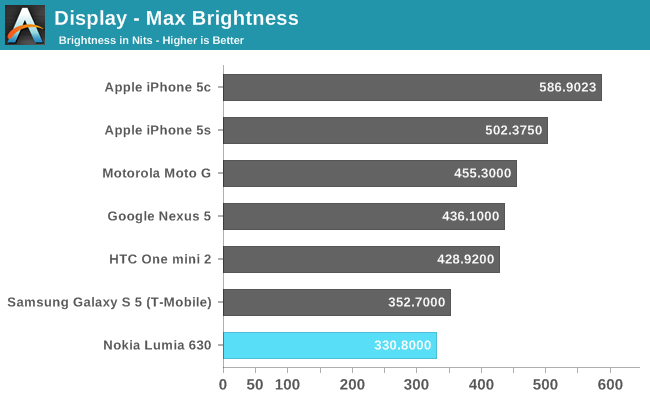
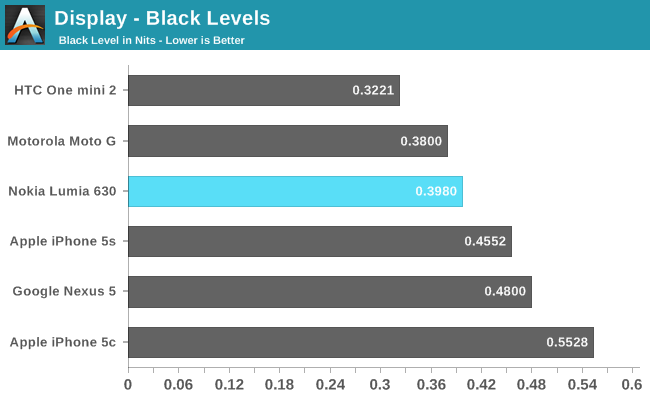
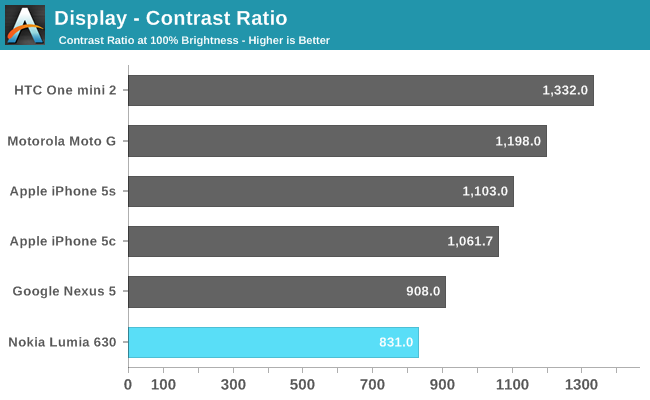
The overall contrast ratio is let down by the lack of a powerful backlight. At the minimum backlight level, the contrast ratio jumps way up to 1500:1. This display is once again bumping into the fact that this phone has competition at this price point, and screen brightness is once again a bit of a let down, but with the ClearBlack system, outdoor readability is still decent.
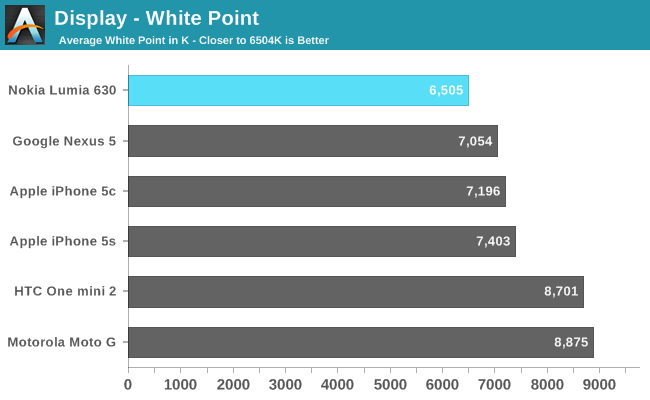
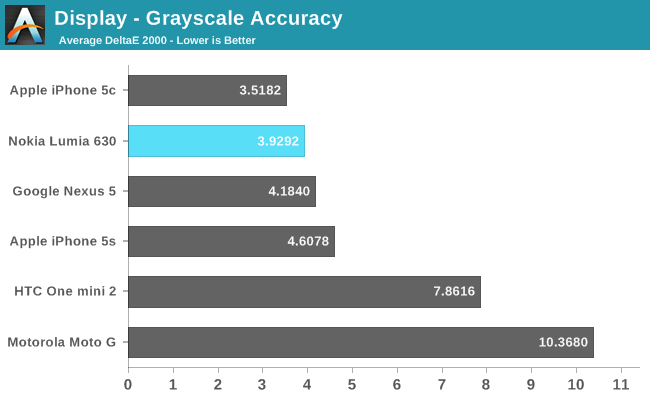
White Point is almost dead on at 6505, but the display is lacking some green. For this reason, you can’t ever just look at color temperature for white and know the whole story. Red is also a bit strong, but overall the grayscale average is quite good for a smartphone, coming in close to the top for grayscale and right at the top for white point. It’s a great start for a low cost phone. Please note that the contrast ratio in the screen capture is not accurate due to the i1Pro not having accurate low light measurements. Let’s continue on and check the color accuracy and saturation sweeps.
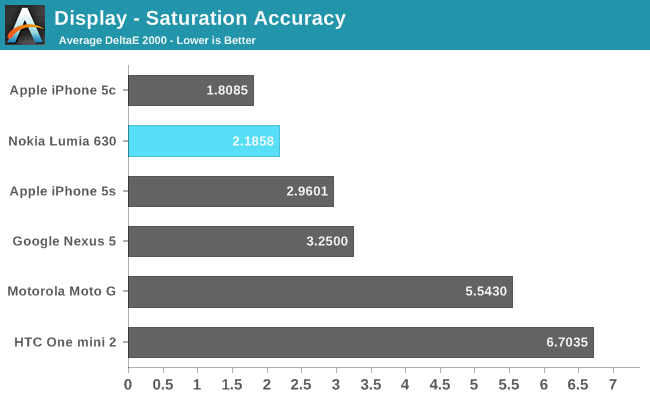
This display is fantastic here, outperforming even the iPhone 5S. While some phones seem to love to oversaturate colors to draw in perspective buyers at the store, the Lumia 630 keeps them almost perfect. If you do prefer to adjust the saturations, you can do that in the display options, but I found that moving them up or down was too drastic of a result, especially when the default setting is almost perfect.
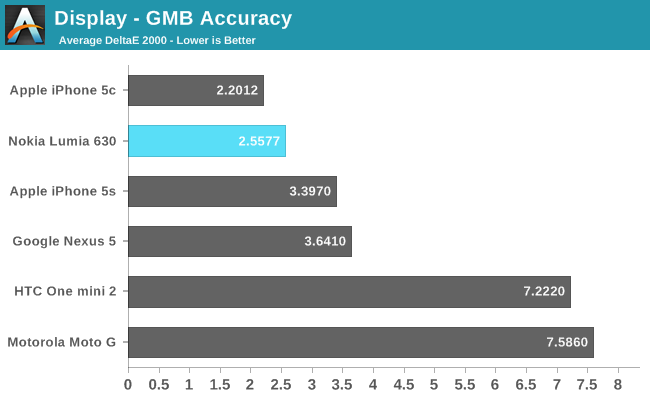
Once again, we have an excellent result in the colorchecker, and once again the Lumia 630 beats out the iPhone 5S for overall accuracy. That’s a pretty fantastic result for a device of this cost. What drives up the average is the relatively poor greyscale performance and the lack of green in the whites, which comes through in the overall rating. You may notice a slightly different chart here than other smartphones, but it’s the same chart just with more colors checked.
I have to commend Nokia on the accuracy of this display out of the box. It’s also important to note that this is the first Lumia (at least that I’ve seen) that has both a brightness slider, and adjustable saturation levels.


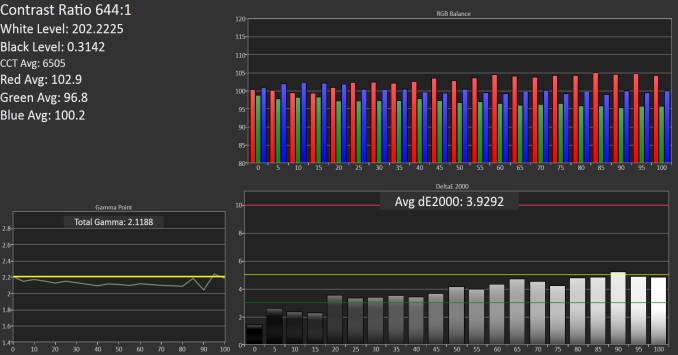










83 Comments
View All Comments
cheshirster - Wednesday, September 17, 2014 - link
520 = 620 performance-wise.cheshirster - Wednesday, September 17, 2014 - link
Stop whining about 512mb RAM, just go and see Lumia 520 vs Lumia 525 sales.See 525 on this chart? Me neither.
http://dzfocdn.dazeinfo.com/wp-content/uploads/201...
yapmeo - Friday, October 17, 2014 - link
"The camera module is a 5 MP 1/4” design. This means the pixels are 1.4 µm."Pixel size: FALSE